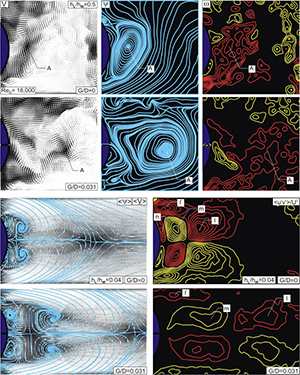You are here
Home ›Passive Control of the Structure of the Near-Wake of a Cylinder in Shallow Flow
Passive Control of the Structure of the Near-Wake of a Cylinder in Shallow Flow. Fully-turbulent shallow flow incident upon a cylinder, whereby the cylinder diameter is significantly larger than the water depth, can give rise to large-scale vortex formation in the near-wake, as shown by the first row of images, taken at an elevation of the laser sheet hL normalized by the depth hw of the shallow layer of hL/hw = 0.5, i.e., along the midplane of the layer. The center of the large-scale vortex is indicated as A in patterns of instantaneous velocity V, streamline Ψ topology and instantaneous vorticity ω. A slot extending through the cylinder can provide passive base bleed and substantially retard the onset of large-scale vortex formation, as indicated in the second row of images. Patterns of velocity V, streamlines Ψ, and instantaneous vorticity ω all indicate that the large-scale vortex is formed a significantly larger distance downstream of the cylinder. In this case, the gap width G normalized by the cylinder diameter D has a value G/D = 0.031.
This retarded vortex formation has important consequences for the flow at the bed, which is represented in the third and fourth row of images. In this case, the laser sheet is located at an elevation hL/hw = 0.04, i.e., immediately adjacent to the bed. Patterns of time-averaged streamlines <Ψ> superposed on time-averaged velocity <V> show translation in the downstream direction of the principal saddle points and foci of the streamline topology in presence of the gap G/D = 0.031, relative to the case of the plain cylinder G/D = 0. Correspondingly, the patterns of Reynolds stress <u′v′>/U2 are fundamentally altered in presence of the gap. They are located much further downstream and have substantially reduced levels for G/D = 0.031 relative to G/D = 0.

